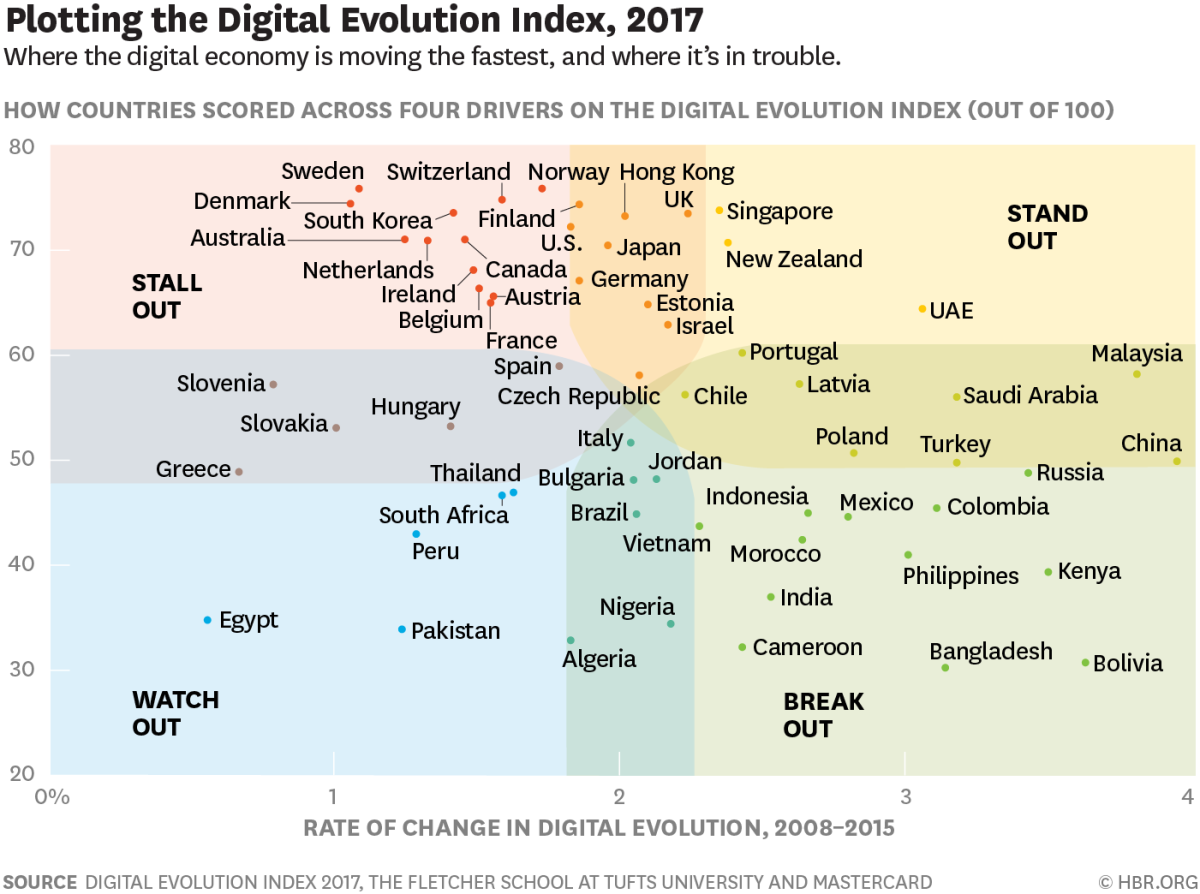Why strengthening the global economy means closing the digital divide

With advanced and emerging economies moving fast to capture new opportunities created by technology, the digital divide is widening at an accelerating pace. Image: REUTERS/Zohra Bensemra
From cloud computing to artificial intelligence, technology is beginning to revolutionize how the world economy functions. But while these shifts are enriching many in the advanced economies, the developing world is at risk of being left behind. To improve the global South’s economic prospects and avoid a deepening of inequality, developing-country policymakers must take seriously the implications of these shifts for their economies and their countries’ position in the global economy.
For years, the “digital divide” was narrowly defined in terms of Internet connectivity. But today, it manifests itself in the way businesses in rich countries use technology to strengthen their control of global value chains and extract a larger share of the value-added created in the developing world.

Consider, for example, how recent innovations threaten the export-oriented industrialization strategy that has fueled many countries’ development in recent decades. By using abundant and low-cost labor, developing countries were able to increase their share of global manufacturing activities, creating jobs, attracting investment and, in some cases, kick-starting a broader industrialization process. But, for the firms that took advantage of the opportunity to reduce costs by shifting manufacturing to the developing world, there was always a trade-off: offshore production meant limited ability to respond quickly to shifts in consumer demand.
Now, technology may offer another option. By investing in “additive manufacturing,” robots, and other non-human tools, companies could move their production sites closer to their final markets. Adidas, for example, is employing some of these technologies to bring footwear “speed factories” to Germany and the United States.
Similarly, as digital technology facilitates the cross-border sale of services, and protections for domestic service providers become increasingly difficult to enforce, domestically oriented services in developing countries will face growing global competition. While such shifts remain nascent, they represent a long-term threat to the development strategies on which many countries in the global South rely.
With advanced and emerging economies moving fast to capture new opportunities created by technology, the digital divide is widening at an accelerating pace. For example, China, which used a protectionist industrial policy to nurture domestic digital giants like Baidu and Tencent, is now supporting these firms as they move deeper into development of new technologies and try to expand globally.
Similarly, the European Union is supporting technology investments through its “digital single market,” and through new policies in areas like venture capital, high-capacity computing, and cloud computing. Indeed, plans for a “European cloud” have been put forth.
There are very few, if any, comparable frameworks currently in place in the global South. This must change, but how?
Development strategists often suggest that poor countries cannot afford to dedicate resources to the digital economy. While that is true to some extent, failing to account for technology-driven economic trends will merely exacerbate the problem.
In fact, such trends should be at the center of national development strategies. Moreover, at a regional level, there is a need to analyze technology-driven economic shifts and design policies that take advantage of the opportunities they represent, while coping with the associated challenges.
In Africa, for example, ongoing efforts to develop regional trade links and boost industrial cooperation – including frameworks like the Continental Free Trade Area (CFTA) initiative and Agenda 2063 – should include a focus on digital transformation strategies. Discussions on this front should be informed by lessons from other regions, such as the EU.
This should occur in the context of broader efforts to help local firms expand and become more competitive internationally. Too often, excitement for Africa’s innovative startup ecosystem masks the challenges, such as small and fragmented domestic markets, that could impede long-term success.
Digital technology has already been put to good use in many parts of the developing world. Data-driven farming techniques are helping growers achieve higher yields, while mobile finance is broadening financial inclusion in poor communities. But these innovations will not be enough to prevent developing countries from falling behind in the global economy. To catch up with the global North, policymakers will need new tools.
To invest in those tools, developing countries will also need support from international organizations. For example, ongoing World Trade Organization discussions about the rules that will govern the digital economy should be expanded to include strategies for leveling the global playing field.
Overcoming the resource constraints that limit developing countries’ investment in the digital economy will not be easy. But failing to do so will carry a steeper price. As leaders in the developing world seek to position their countries for sustainable growth, they must think globally and locally, without losing sight of the role that technology will play in shaping the economy of tomorrow.
This commentary draws on research with Christopher Foster and Jaime Echavarri of the University of Sheffield exploring digital trade and its impacts on development.
Don't miss any update on this topic
Create a free account and access your personalized content collection with our latest publications and analyses.
License and Republishing
World Economic Forum articles may be republished in accordance with the Creative Commons Attribution-NonCommercial-NoDerivatives 4.0 International Public License, and in accordance with our Terms of Use.
The views expressed in this article are those of the author alone and not the World Economic Forum.
Stay up to date:
The Digital Economy
Related topics:
Forum Stories newsletter
Bringing you weekly curated insights and analysis on the global issues that matter.
More on Equity, Diversity and InclusionSee all
Marielle Anzelone and Georgia Silvera Seamans
October 31, 2025






